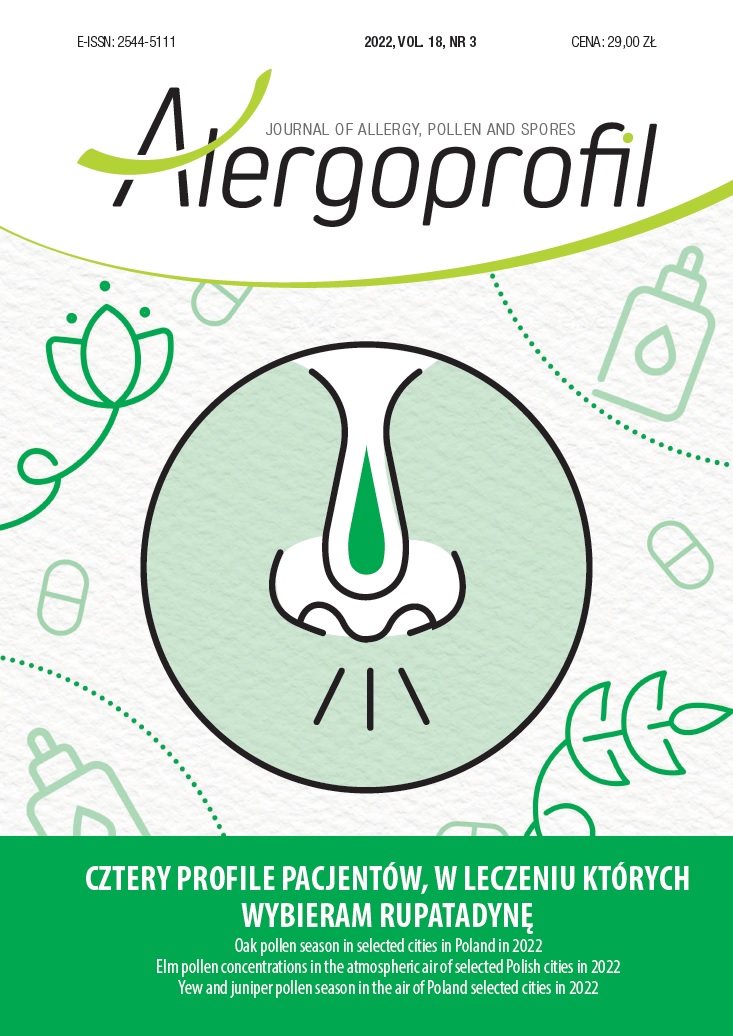Oak pollen season in selected cities in Poland in 2022 Original article
Main Article Content
Abstract
Oak (Quercus sp.) is a common species in Poland. Que a 1, which triggers allergic reactions in spring, is the main oak allergen. The aim of the study was to compare the oak pollen season in 13 Polish cities in 2022. Pollen was monitored with the volumetric method. The analyses determined the annual sum of pollen grains, the length of the pollen season (using the 98% method), the highest peak pollen concentrations, the dates of maximum pollen concentrations, and the number of days with pollen concentrations above threshold values causing clinical allergy symptoms. The earliest onset of the oak pollen season was noted in Szczecin (April 11th), and the latest beginning was recorded in Lublin and Kielce (May 5th). The shortest and the longest pollen seasons were recorded in Cracow (22 days) and in Szczecin (48 days), respectively. The highest total daily concentration of pollen grains was recorded in Opole (5083) and the lowest value was noted in Bialystok (112) and Szczecin (328). The highest maximum concentration of oak pollen was recorded in Sosnowiec and Kielce (625 and 543 grains/m3, respectively), whereas the lowest values were noted in Bialystok and Szczecin (27 and 47 grains/m3, respectively). In most of the analyzed cities in Poland, the peak oak pollen release was recorded between May 7th and 12th. The highest risk of allergic reactions caused by oak pollen allergens was reported from Opole, Piotrkow Trybunalski, and Zielona Gora.
Downloads
Article Details

This work is licensed under a Creative Commons Attribution-NonCommercial 4.0 International License.
Copyright: © Medical Education sp. z o.o. This is an Open Access article distributed under the terms of the Attribution-NonCommercial 4.0 International (CC BY-NC 4.0). License (https://creativecommons.org/licenses/by-nc/4.0/), allowing third parties to copy and redistribute the material in any medium or format and to remix, transform, and build upon the material, provided the original work is properly cited and states its license.
Address reprint requests to: Medical Education, Marcin Kuźma (marcin.kuzma@mededu.pl)
References
2. Wrońska-Pilarek D, Danielewicz W, Bocianowski J et al. Comparative pollen morphological analysis and its systematic implications on three European oak (Quercus L., Fagaceae) species and their spontaneous hybrids. PLoS ONE. 2016; 11(8):e0161762. https://doi.org/10.1371/journal.pone.0161762.
3. Panahi P, Pourmajidian MR, Fallah A et al. Pollen morphology of Quercus (subgenus Quercus, section Quercus) in Iran and its systematic implication. Acta Societatis Botanicorum Poloniae. 2012; 81(1): 33-41. https://doi.org/10.5586/asbp.2012.005.
4. Rapiejko A, Malkiewicz M, Ziemianin M et al. Oak pollen concentration in the air of selected Polish cities in 2020. Alergoprofil. 2020; 16(4): 15-20. https://doi.org/10.24292/01.AP.1643311220.3.
5. Rapiejko P. Alergeny pyłku dębu. Alergoprofil. 2007; 3(3): 34-8.
6. Lipiec A, Puc M, Malkiewicz M et al. Analiza stężenia pyłku dębu w wybranych miastach Polski w 2015 r. Alergoprofil. 2015; 11(3): 45-9.
7. Dąbrowska-Zapart K, Chłopek K, Malkiewicz M et al. Oak pollen season in selected cities of Poland in 2019. Alergoprofil. 2019; 15(2): 12-6. https://doi.org/10.24292/01.AP.152150919.
8. Puc M, Myszkowska D, Chłopek K et al. Pyłek dębu w powietrzu Polski w 2017 r. Alergoprofil. 2017; 13(3): 124-8. https://doi.org/10.24292/01.ap.300917.
9. Kopacz-Bednarska A, Ślusarczyk J, Posłowska J. Oak and hornbeam pollen season in Kielce in 2021. Alergoprofil. 2022; 18(1): 21-8. https://doi.org/10.24292/01.AP.181050322.
10. Weryszko-Chmielewska E, Piotrowska K. Cechy morfologiczne kwiatów i pyłku wybranych roślin alergennych. In: Weryszko-Chmielewska E. Aerobiologia. Wyd. Akademii Rolniczej, Lublin 2007: 95-137.
11. Hauser M, Roulias A, Ferreira F et al. Panallergens and their impact on the allergic patient. Allergy Asthma Clin Immunol. 2010; 6: 1. https://doi.org/10.1186/1710-1492-6-1 .
12. Majsiak E, Buczyłko K. Częstość występowania swoistych immunoglobulin E dla alergenu brzozy, olchy, leszczyny i dębu wśród 8254 osób z różnych regionów Polski. Alergoprofil. 2016; 12(2): 74-80.
13. Emberlin J, Savage M, Jones S. Annual variations in grass pollen seasons in London 1961-1990: trends and forecast models. Clin Exp Allergy. 1993; 23(11): 911-8.
14. Burge HA. Monitoring for airborne allergens. Ann Allergy. 1992; 9: 9-21.
15. Sulborska A, Weryszko-Chmielewska E, Piotrowska-Weryszko K et al. Stężenie pyłku dębu w powietrzu wybranych miast w Polsce w 2018 r. Alergoprofil. 2018; 14(3): 67-71. https://doi.org/10.24292/01.AP.290918.

